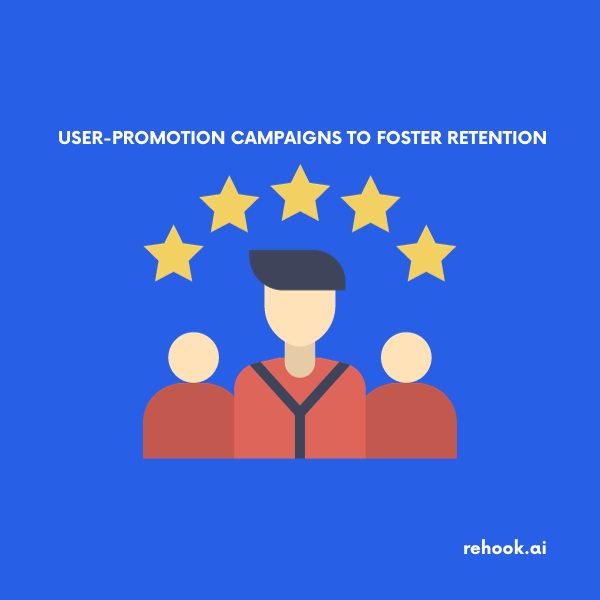
How can user-promotion campaigns foster retention? Tips, trends and examples
Understand different types of customer incentives, the benefits of using incentives to retain customers, and tips for creating effective incentive campaigns that keep up with your user's evolving needs.
Any B2C company in today's highly competitive business landscape understands that retaining customers is now more important than ever. Not only does customer retention provide a steady stream of revenue for businesses, but loyal customers solve for marketing cost reduction and sustainable growth.
One of the most successful ways for businesses to boost their customer retention is by launching user-incentive campaigns. Customer incentives are rewards or benefits that businesses offer to customers in exchange for their loyalty. These incentives can come in many forms, such as discounts, loyalty programs, referral programs, free samples, and rewards. By offering incentives, businesses can encourage their customers to continue working with them, increase customer satisfaction, and build brand loyalty.
Let’s explore how customer incentives can boost retention and look at real-world examples of businesses that have successfully used these strategies. We'll discuss different types of customer incentives, the benefits of using incentives to retain customers, and offer tips for creating effective incentive programs.
Types of User Incentivization Campaigns:
There are many different types of incentivization campaigns that businesses can use to encourage customer loyalty and retention. Here are some of the most common ones:
Discounts and Coupons
Offering discounts and coupons is one of the simplest and most effective ways to incentivize customers to continue doing business with your company. A study by RetailMeNot found that 80% of shoppers said they would switch to a brand that offered a discount over one that did not.
Discounts can take many forms, such as percentage off coupons, amount off coupons, and buy-one-get-one-free offers. Customers appreciate feeling like they are getting a good deal, and offering discounts can be a great way to retain customers.
Loyalty Programs
Loyalty programs are a structured way to reward customers for repeat business. These programs can be very effective in boosting retention. According to a study by Bond Brand Loyalty, 63% of consumers said they modify their spending habits to maximize loyalty rewards. As customers accumulate points, they can redeem them for rewards such as discounts, free products, or exclusive experiences. Loyalty programs can be a powerful tool for building customer loyalty, as customers feel like they are being rewarded for their loyalty to your brand.
Referral Programs
Referral programs incentivize customers to refer their friends and family to your business. This is typically done by offering rewards to both the referrer and the new customer. For example, a business might offer a discount to the new customer and a free product or service to the referrer. Referral programs can be an effective way to acquire new customers while also retaining existing ones. According to a study by Nielsen, people are four times more likely to buy when referred by a friend.
Cash Back or Rewards
Cash back and reward programs give customers a financial incentive to continue doing business with your company. For example, a credit card company might offer cash back on purchases, or a retailer might offer reward points that can be redeemed for future purchases. These types of programs can be especially effective for customers who are motivated by financial rewards.
According to a study by Blackhawk Network, 77% of shoppers say they are more likely to continue doing business with a brand that offers rewards.
Gamification
Gamification is the use of game mechanics and design elements to engage and motivate customers. This can include things like leaderboards, badges, and challenges. By adding a fun and competitive element to your customer retention strategy, you can encourage customers to continue doing business with you and build a sense of community around your brand. According to a study by Badgeville, gamification can increase customer engagement by as much as 48%.
By offering customer incentives, businesses can increase customer satisfaction, build brand loyalty, and boost retention rates. In the next section, we'll look at real-world examples of businesses that have successfully used customer incentives to achieve these benefits.
How Successful Companies have leveraged User Incentivization:
Discounts and Coupons
- Kohl's: As mentioned earlier, Kohl's has a rewards program that offers customers discounts on future purchases based on how much they spend. Customers who spend $600 or more per year can become "Kohl's Most Valued Customers," which gives them access to additional discounts and other perks. The program has been successful in keeping customers coming back to Kohl's, with the company reporting that its most loyal customers account for around 70% of its sales.
- Bed Bath & Beyond: Bed Bath & Beyond offers customers a 20% off coupon for signing up for its email newsletter. This has been successful in getting new customers to make their first purchase with the company, and has also encouraged them to continue shopping with Bed Bath & Beyond in the future.
Loyalty Programs
- Sephora: Sephora's Beauty Insider program offers customers points for purchases that can be redeemed for free products or discounts. The program has been successful in encouraging customers to make repeat purchases, with Sephora reporting that its Beauty Insider members spend twice as much as non-members.
- Amazon Prime: Amazon's Prime program offers customers free two-day shipping on eligible items, as well as access to streaming video and music services. The program has been successful in increasing customer loyalty, with Prime members spending more than twice as much as non-Prime members on Amazon.
Referral Programs
- Uber: Uber's referral program offers both the referrer and the new customer a discount on their next ride. This has been successful in getting customers to refer their friends and family to Uber, which has helped the company acquire new customers while also retaining existing ones.
- Airbnb: Airbnb's referral program offers both the referrer and the new customer a discount on their next booking. This has been successful in getting customers to refer their friends and family to Airbnb, which has helped the company acquire new customers at a very low cost.
Free Samples or Trials
- Blue Apron: Blue Apron offers new customers a discount on their first box of meal kits, as well as the option to try a free sample box. This has been successful in getting customers to try Blue Apron's products and has helped to build trust and credibility with the brand.
- Spotify: Spotify offers new customers a free trial of its premium music streaming service. This has been successful in getting customers to try Spotify's premium service and has helped the company acquire new customers.
Cash Back Rewards
- Chase Freedom: Chase Freedom offers customers 1-5% cash back on purchases, depending on the category of the purchase. This has been successful in encouraging customers to use their Chase Freedom card for purchases.
- American Express: American Express offers customers various rewards for using their card, such as airline miles, hotel points, or cash back. This has helped to build loyalty to the brand.
Benefits of using customer incentives to boost retention:
- Increased customer loyalty: Customer incentives have been shown to be effective in increasing customer loyalty. According to a study by Bond Brand Loyalty, 77% of customers who participated in loyalty programs said they were more likely to continue doing business with a company that offers a loyalty program.
- Improved customer retention: A study by Bain & Company found that increasing customer retention rates by just 5% can increase profits by 25% to 95%. By offering incentives for continued business or referrals, companies can improve their customer retention rates and reduce customer churn.
- Cost-effective marketing: According to a study by the Word of Mouth Marketing Association, referral marketing generates 3-5 times higher conversion rates than any other marketing channel. By offering incentives to existing customers for referrals, companies can acquire new customers without incurring high advertising or marketing costs.
- Increased customer lifetime value: According to a study by Epsilon, customers enrolled in loyalty programs generate 12-18% more revenue than non-members. By encouraging customers to make repeat purchases or referrals, companies can increase their customer lifetime value and generate more revenue.
- Competitive advantage: According to a study by Deloitte, 53% of consumers say they are more likely to choose a retailer based on a loyalty program. Offering customer incentives can differentiate a company's offerings from its competitors and help to build brand loyalty.
- Better customer relationships: According to a study by Accenture, 52% of customers who participate in loyalty programs say they feel more emotionally connected to the brand. By offering incentives, companies can show their customers that they value their business and are willing to invest in their relationship, leading to stronger relationships with customers and improved overall satisfaction with the company.
Tips for launching effective customer incentive campaigns:
Creating effective customer incentive programs can be challenging, but the following tips can help companies to design programs that are both effective and sustainable:
- Understand your customers: Before creating a customer incentive program, it's important to understand what motivates your customers. Consider conducting surveys or focus groups to gather information on what types of incentives would be most appealing to your target audience.
- Set clear goals: Determine what you want to achieve with your customer incentive program, whether it's to increase sales, improve customer retention, or acquire new customers. Setting clear goals will help you to design a program that is focused and effective.
- Make it easy to participate: Ensure that your incentive program is easy to understand and participate in. Avoid complex or confusing rules or requirements, as this can discourage participation.
- Offer relevant incentives: Offer incentives that are relevant to your customers and align with their interests and values. This can include discounts, free products, access to exclusive content or events, or other rewards.
- Provide ongoing communication: Keep your customers informed about the program and its benefits through regular communication, such as emails, social media posts, or in-store signage.
- Measure and adjust: Track the success of your incentive program and make adjustments as needed. This can include modifying the incentives offered, changing program rules, or adjusting communication strategies.
In conclusion, customer incentives can be a powerful tool for companies looking to boost customer retention. By offering incentives such as rewards programs, referral programs, and other types of rewards, companies can increase customer loyalty, improve retention rates, and generate more revenue. Effective customer incentive programs require a deep understanding of customer needs and motivations, clear goals, and ongoing communication with customers. By following these best practices, companies can create programs that not only reward customers for their loyalty but also build stronger relationships with them. Ultimately, effective customer incentive programs can help companies to differentiate themselves from their competitors, drive business growth, and create more loyal and satisfied customers.
